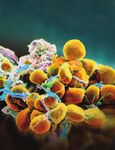Antenatal spontaneous renal forniceal rupture presenting as an acute abdomen
←
→
Page content transcription
If your browser does not render page correctly, please read the page content below
Washington University School of Medicine Digital Commons@Becker Open Access Publications 2018 Antenatal spontaneous renal forniceal rupture presenting as an acute abdomen Jennifer Travieso Washington University School of Medicine in St. Louis Omar M. Young Washington University School of Medicine in St. Louis Follow this and additional works at: https://digitalcommons.wustl.edu/open_access_pubs Recommended Citation Travieso, Jennifer and Young, Omar M., ,"Antenatal spontaneous renal forniceal rupture presenting as an acute abdomen." Case Reports in Medicine.2018,8596491. 1-3. (2018). https://digitalcommons.wustl.edu/open_access_pubs/6841 This Open Access Publication is brought to you for free and open access by Digital Commons@Becker. It has been accepted for inclusion in Open Access Publications by an authorized administrator of Digital Commons@Becker. For more information, please contact engeszer@wustl.edu.
Hindawi
Case Reports in Medicine
Volume 2018, Article ID 8596491, 3 pages
https://doi.org/10.1155/2018/8596491
Case Report
Antenatal Spontaneous Renal Forniceal Rupture Presenting as an
Acute Abdomen
Jennifer Travieso1 and Omar M. Young 1,2
1
Department of Obstetrics and Gynecology, Washington University School of Medicine, St. Louis, MO, USA
2
Division of Maternal-Fetal Medicine and Ultrasound, Department of Obstetrics and Gynecology,
Washington University School of Medicine, St. Louis, MO, USA
Correspondence should be addressed to Omar M. Young; youngom@wustl.edu
Received 28 December 2017; Accepted 27 March 2018; Published 10 April 2018
Academic Editor: Georgios D. Kotzalidis
Copyright © 2018 Jennifer Travieso and Omar M. Young. This is an open access article distributed under the Creative Commons
Attribution License, which permits unrestricted use, distribution, and reproduction in any medium, provided the original work is
properly cited.
Background. Renal forniceal rupture is a lesser-known cause of acute abdomen in pregnancy. The ureteral compression by the
gravid uterus places pregnant women at a higher risk. Sequelae in pregnancy could include intractable pain, acute kidney injury,
and preterm birth. Case. A 22-year-old primigravida with no prior medical history presented with an acute abdomen in her second
trimester. The diagnosis of renal forniceal rupture was made by a radiologist using MRI. A percutaneous nephrostomy catheter
was placed, and the patient’s pain was relieved. She subsequently delivered at term. Conclusion. Upon presentation of an acute
abdomen in pregnancy, providers may not include renal forniceal rupture in their differential as readily as obstetric or gynecologic
causes, resulting in delayed diagnosis, unnecessary invasive interventions, and potentially adverse maternal and neonatal
outcomes. Increasing provider awareness could result in improved outcomes.
1. Introduction acute abdomen in pregnancy. We present a case of renal
forniceal rupture presenting in this manner to highlight
Renal forniceal rupture is the extravasation of urine from a condition where provider familiarity may be low and
one or more renal calyces caused by increased pressure in the diligence in diagnosis is required, particularly in settings
renal collecting system [1]. The increase in pressure is without availability of immediate radiologic diagnosis or
secondary to obstruction, most commonly caused by expeditious surgical intervention.
nephrolithiasis. It can also be secondary to malignancy,
infectious etiology, iatrogenic injury, and least commonly,
pregnancy [2]. A patient may present with nondiscrete flank
2. Case
pain or even mimic someone with an acute surgical abdo- A 25-year-old primigravida with no significant past medical
men. Lack of provider awareness of the diagnosis has led to history at 22 weeks and 0 days gestation presented to a local
unnecessary open surgery [3]. In addition, untreated or hospital with sudden onset of right-sided back pain radiating
undertreated forniceal rupture has been associated with to her right lower quadrant that had persisted for less than
preterm birth and acute kidney injury requiring hemodi- one day. She denied nausea, vomiting, fevers, vaginal
alysis [4–6]. The documented cases of preterm birth asso- bleeding, and dysuria. Her pregnancy had been otherwise
ciated with this condition followed spontaneous preterm uncomplicated. Her pain became uncontrollable with in-
labor or was the result of emergent cesarean for non- travenous medication and localized solely to her right lower
reassuring fetal status. The formulation of a broad differ- quadrant. She was transferred to a tertiary care center for
ential including conditions outside of obstetrics or further management, given concern for appendicitis and
gynecology is critical for providers when presented with an possible need for surgical intervention.2 Case Reports in Medicine
3. Discussion
The diagnosis of renal forniceal rupture in pregnancy is not
straightforward. While flank pain or costovertebral angle
tenderness may prompt this consideration in the non-
pregnant patient, an acute abdomen in a pregnant patient
may not. The physiology of pregnancy often obscures di-
agnoses that are otherwise readily made. A gravid uterus
displacing the appendix may result in an atypical pre-
sentation of appendicitis. Similarly, the physiologic dilation
of the ureters described above can both predispose to this
Figure 1: Coronal slice of MRI obtained on admission showing condition, and knowledge of this physiology can complicate
right hydroureter (arrowhead) and fluid extravasation surrounding radiologic interpretation. Provider awareness and diligence
the right kidney (arrow). in creating an exhaustive differential, obtaining appropriate
imaging in the stable patient as outlined below, and con-
tacting appropriate teams for treatment can prevent un-
Her pain worsened on transport, and on arrival to the necessary procedures and adverse outcomes in the pregnant
tertiary care center, she demonstrated severe right lower patient with forniceal rupture.
quadrant tenderness with rebound and voluntary guarding Spontaneous renal forniceal rupture is caused by various
without costovertebral angle tenderness. She was hemody- etiologies resulting in an increase in pressure. This diagnosis
namically stable, but intravenous hydromorphone only is not exclusive to pregnancy, and in a retrospective review of
provided transient and mild improvement in her pain. Her forniceal rupture, ureteric stones were the cause in 74% of
cervix was found to be closed on digital exam, and no ab- cases. Other causes included malignant (8%) or benign (2%)
normalities were noted on speculum exam. Initial laboratory extrinsic compression, anatomic obstruction (4%), and
evaluation demonstrated a normal comprehensive metabolic iatrogenic causes (4%) [2]. While this review included one
panel and coagulation studies. Hemoglobin was 10.7 gm/dL pregnant patient, another review was performed solely on
and white blood cell count was not elevated (9.9 × 103/μL). pregnant patients with forniceal rupture. This review of
Urinalysis was negative. 15 cases showed structural causes such as vesicoureteral
She underwent an abdominal MRI showing a normal reflux or infectious causes such as pyelonephritis and abscess
appendix. However, in a verbal read from the on-call ra- as the explanation in 5 cases (31%), benign tumors as the
diologist, concern was communicated for right forniceal cause in 4 cases (25%), and most significantly, no cause other
rupture given the constellation of radiologic findings of than pregnancy found in 6 cases (38%) [7]. Compression of
hydroureter combined with perinephric and retroperitoneal the ureters by the gravid uterus is the cause for the increase
fluid, highlighted in Figure 1. Her left kidney and collecting in pressure responsible for rupture. At 20 weeks of gestation,
system were normal in appearance. Renal ultrasound was 76% of pregnant patients will demonstrate right-sided
therefore performed, and it revealed right ureteral tapering hydroureter and 36% left-sided. Anatomical differences in
between the gravid uterus and right iliac artery with no right the courses of the ovarian veins are thought to be responsible
ureteral jet visualized. Given these findings, the patient was as the right-sided vessel courses across the ureter to enter the
subsequently managed by a multidisciplinary team con- vena cava. In contrast, the left-sided vessel runs in parallel
sisting of maternal-fetal medicine, urology, and interven- with the ureter and enters the renal vein [8]. Correspond-
tional radiology. Three strategies were discussed and ingly, rupture in pregnant patients occurs on the right in
included conservative management with close follow-up, 88% of cases [8], whereas rupture in nonpregnant patients is
placement of a ureteral stent, and placement of a percuta- right-sided only 49% of the time [2].
neous nephrostomy (PCN) tube. Patient preference was for Presentation of an acute abdomen in pregnancy requires
PCN placement. Of note, urine culture collected prior to prompt and directed evaluation while also ensuring patient
PCN placement was negative. stability and fetal reassurance. The differential should be
Following its placement by interventional radiology, her organized into the following etiological categories:
pain was relieved, and she was discharged with follow-up obstetric/gynecologic (placental abruption, preterm labor,
with maternal-fetal medicine and interventional radiology. ectopic or heterotopic pregnancy, ovarian cysts or tumors,
Her pregnancy was subsequently complicated by read- pelvic inflammatory disease, and degeneration of fibroid
mission for recurrent pain and pyelonephritis with culture tumors), renal/urologic (nephrolithiasis, pyelonephritis,
isolation of Enterobacter cloacae resistant to both nitrofu- spontaneous forniceal rupture, and renal malignancy), and
rantoin and trimethoprim/sulfamethoxazole (TMP-SMX). gastrointestinal/hepatobiliary (appendicitis, pancreatitis,
She required placement of a midline IV for daily infusion gallbladder disease, inflammatory bowel disease, and bowel
of ertapenem at her local hospital. Her pregnancy was obstruction) [4, 7]. While spontaneous renal forniceal
also complicated by fetal growth restriction, diagnosed at rupture does not invariably present as an acute abdomen,
35 weeks. Uncomplicated vaginal delivery occurred at improving provider awareness of this entity can prevent
37 weeks and 1 day. Her PCN was removed postpartum delaying accurate diagnosis. Misdiagnosis has led to pre-
at which point antibiotics were also discontinued. viously documented unnecessary invasive interventions andCase Reports in Medicine 3
adverse obstetric outcomes. In a case of misdiagnosis, [3] L. M. Fluke, B. D. Hoagland, S. M. Bedzis, and M. G. Johnston,
a primigravida patient suspected to have appendicitis un- “Spontaneous renal calcyeal rupture: a rare cause of acute
derwent an urgent exploratory laparotomy, revealing a nor- abdomen in pregnancy,” American Surgeon, vol. 82, no. 8,
mal appendix. Further intraoperative studies were then pp. 196-197, 2016.
undertaken and revealed her symptoms to have been caused [4] B. Hanson and R. Tabbarah, “Preterm delivery in the setting of
left calyceal rupture,” Case Reports in Obstetrics and Gyne-
by forniceal rupture [3]. In a case of delayed diagnosis,
cology, vol. 2015, Article ID 906073, 4 pages, 2015.
a primigravida at 33 weeks presented with threatened preterm [5] K. L. Lo, C. F. Ng, and W. S. Wong, “Spontaneous rupture of
labor and flank tenderness with sterile urine. After an un- the left renal collecting system during pregnancy,” Hong Kong
remarkable ultrasound, she was conservatively managed for Medical Journal, vol. 13, no. 5, pp. 396–398, 2007.
renal colic, until repeated episodes of pain prompted an MRI [6] L. M. Sidra, R. Keriakos, A. G. Shayeb, N. Kumar, and S. Najia,
showing calyceal rupture and leak. Stent placement was “Rupture renal pelvicalyceal system during pregnancy,” Journal
planned by urology, but rapidly progressing preterm labor of Obstetrics and Gynaecology, vol. 25, no. 1, pp. 61–63, 2005.
resulted in delivery 3 hours later [4]. Not enough cases of [7] S. Satoh, A. Okuma, Y. Fujita, M. Tamaka, and H. Nakano,
rupture exist in the literature to draw a conclusion about the “Spontaneous rupture of the renal pelvis during pregnancy:
correlation between forniceal rupture and preterm birth, but case report and review of the literature,” American Journal of
Perinatology, vol. 19, pp. 189–195, 2002.
the pathophysiology is plausible with inflammation, tissue
[8] P. E. Rasmussen and F. R. Nielsen, “Hydronephrosis during
injury, and peritoneal irritation from urine resulting in pregnancy: a literature survey,” European Journal of Obstetrics
preterm labor. More research is required to determine if & Gynecology and Reproductive Biology, vol. 27, no. 3,
forniceal rupture and preterm birth are clinically correlated pp. 249–259, 1988.
and if there is an underlying physiologic mechanism.
Management of forniceal rupture is straightforward and
requires placement of either a ureteral stent or percutaneous
nephrostomy catheter, whereas detecting the diagnosis is
arguably more difficult. This is likely secondary to an un-
derstandable lack of provider awareness, given that less than
35 cases exist in the literature as recently as 2016 [3]. Ad-
ditionally, radiologic diagnosis is usually required. Ideal
examinations include CT with IV contrast using renal
protocol or IV urogram, which are not ideal in pregnancy
[1]. MRI or ultrasound has been successfully used in the
cases presented [1, 4]. The diagnosis can be made by any one
of the following criteria being met: irregularity of a single
renal calyx, loss of the ability to discern renal sinus fat,
asymmetrically distributed perinephric stranding, and
a discreet perinephric fluid collection [2]. Not all centers are
equipped to provide this imaging or interpretation, and in
these cases, the responsibility for higher suspicion and ap-
propriate triage falls to the provider available.
Additional Points
Prompt diagnosis of antenatal renal forniceal rupture can
prevent unnecessary interventions and adverse outcomes;
however, such diagnosis requires increased provider
awareness.
Conflicts of Interest
The authors declare that they have no conflicts of interest.
References
[1] I. K. Jalbani and M. H. Ather, “Renal forniceal rupture in
pregnancy secondary to obstructive renal stone presenting with
acute renal failure,” Saudi Journal of Kidney Diseases and
Transplantation, vol. 25, no. 5, pp. 1081–1083, 2014.
[2] B. Gershman, N. Kulkarni, D. V. Sahani, and B. H. Eisner,
“Causes of renal forniceal rupture,” BJU International, vol. 108,
no. 11, pp. 1909–1911, 2011.MEDIATORS of
INFLAMMATION
The Scientific Gastroenterology Journal of
World Journal
Hindawi Publishing Corporation
Research and Practice
Hindawi
Hindawi
Diabetes Research
Hindawi
Disease Markers
Hindawi
www.hindawi.com Volume 2018
http://www.hindawi.com
www.hindawi.com Volume 2018
2013 www.hindawi.com Volume 2018 www.hindawi.com Volume 2018 www.hindawi.com Volume 2018
Journal of International Journal of
Immunology Research
Hindawi
Endocrinology
Hindawi
www.hindawi.com Volume 2018 www.hindawi.com Volume 2018
Submit your manuscripts at
www.hindawi.com
BioMed
PPAR Research
Hindawi
Research International
Hindawi
www.hindawi.com Volume 2018 www.hindawi.com Volume 2018
Journal of
Obesity
Evidence-Based
Journal of Stem Cells Complementary and Journal of
Ophthalmology
Hindawi
International
Hindawi
Alternative Medicine
Hindawi Hindawi
Oncology
Hindawi
www.hindawi.com Volume 2018 www.hindawi.com Volume 2018 www.hindawi.com Volume 2018 www.hindawi.com Volume 2018 www.hindawi.com Volume 2013
Parkinson’s
Disease
Computational and
Mathematical Methods
in Medicine
Behavioural
Neurology
AIDS
Research and Treatment
Oxidative Medicine and
Cellular Longevity
Hindawi Hindawi Hindawi Hindawi Hindawi
www.hindawi.com Volume 2018 www.hindawi.com Volume 2018 www.hindawi.com Volume 2018 www.hindawi.com Volume 2018 www.hindawi.com Volume 2018You can also read



























































